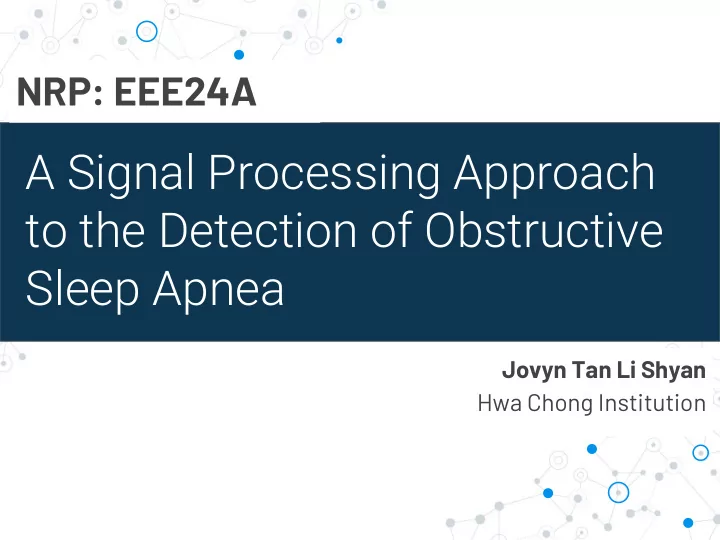

NRP: EEE24A A Signal Processing Approach to the Detection of Obstructive Sleep Apnea Jovyn Tan Li Shyan Hwa Chong Institution
OSA: Obstructive Sleep Apnea Health Complications Heart disease High blood pressure 1 in 3 1 billion people Daytime fatigue Singaporeans worldwide ❏ Sleep disorder where breathing stops for ❏ at least 10 seconds, ❏ more than 5 times/hour 2
Current Form of Diagnosis Polysomnography (PSG) Electromyogram Electro-oculogram Electromyogram Electrocardiogram 3
Aims & Objectives Current Form of Problems Aims of Research Diagnosis 1 Polysomnography Distorts OSA (PSG) condition An automated system without full PSG Cannot analyse Manual data all data collected analysis 3 3-class Fisher’s Ratio 2 Apnea Hypopnea No differentiation Automated 3-class system of event severity Index (AHI) (Healthy, Hypopnea, Apnea) 4
OSA Diagnosis Electromyogram Electro-oculogram Electromyogram Electrocardiogram Proposed method Oro-nasal thermistor Respiratory effort belts 5
Data 14 channels s n o i t a v r e s b o a t a D S a m p l i n g r a t e : 6 4 H z 6 4 H z * 6 0 s * 6 0 m i n * 6 . 2 h = 1 4 2 8 4 8 0 d a t a p o i n t s 6
Methodology Preparation of data for machine learning Signals extracted from data ● Oro-nasal airflow ● Rib cage movement Normalisation ● Abdomen movement 7
Methodology Preparation of data for machine learning Signals extracted from data ● Oro-nasal airflow ● Rib cage movement Segmentation Feature Normalisation ● Abdomen movement windows of 1024 Extraction data points 1024 points = 1 window 8
Feature Extraction ❏ 15 features extracted from each signal ❏ e.g. mean peak prominence, number of peaks ❏ 5 peak processing thresholds 9
Methodology Preparation of data for machine learning Signals extracted from data ● Oro-nasal airflow ● Rib cage movement Segmentation Feature Normalisation ● Abdomen movement windows of 1024 Extraction data points Feature Selection Conceptualising 3-class Fisher’s Ratio By box plot By 3-class analysis Fisher’s ratio 10
Fisher’s Ratio ❏ Measures discriminating power of a variable ❏ 2-Class FR: 11
3-Class Fisher’s Ratio 12
Feature Selection by Box Plots Suitable feature Unsuitable feature 13
Methodology Preparation of data for machine learning Signals extracted from data ● Oro-nasal airflow ● Rib cage movement Segmentation Feature Normalisation ● Abdomen movement windows of 1024 Extraction data points Feature Selection Support Vector Machines Conceptualising (SVM) using Matlab 3-class Fisher’s Ratio By box plot By 3-class analysis Fisher’s ratio Feature Elimination Recursive Feature Elimination Principal Component Analysis (PCA) 14
Classification Results 2 Classes 3 Classes 15
Results [2 classes] Standard Deviation of Peak Prominence of 2 Signals Healthy Ribcage and Abdomen Movements True Class Apnea Healthy Apnea Oro-nasal Airflow Predicted Class Cubic kernel Highest Accuracy: 94.8% 28/28 features Sensitivity: 96% No PCA Specificity: 93% Selection by FR 16
Results [3 class] Standard Deviation of Peak Prominence of 2 Signals Healthy Ribcage and Abdomen Movements Mild Apnea True Class Severe Apnea Healthy Mild Apnea Severe Apnea Predicted Class Oro-nasal Airflow Medium Gaussian kernel Highest Accuracy: 19/28 features 83.4% Selection by box plots PCA enabled 17
Conclusion 1 An automated system without full PSG 2 3-class Fisher’s Ratio 3 An automated 3-class system (Healthy, Hypopnea, Apnea) 18
Recommend
More recommend